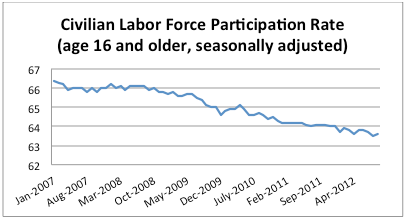Earlier this month, the jobs report released by the federal government indicated 114,000 payroll jobs gained nationwide over the month, a modest number, but the unemployment rate went down significantly from 8.1% to 7.8%.
As Marc Lacter of LA Biz Observed notes, normally a one month job report would not be worthy of great attention, given that job gains and rates go up and down. But this report has generated a lot of controversy about its integrity and meaning. As we get ready to receive our state report this Friday, a few words are in order about the report and its meaning for California.
The national unemployment rate declined in good part because the rate counts include millions of workers whose attachment to full-time work is tenuous. These workers include those involuntarily working part time and those who say they are self-employed, but have no steady income. The unemployment rate also reflects the continuing twenty-year low labor force participation rate.
Workers involuntarily working part-time but seeking full time work: There are currently 8.48 million non-agricultural workers classified as employed, but who are working part-time, even though they seek full time work. This number jumped by 581,000 workers from August to September.
Workers Counted as Employed But Involuntarily Working Part-Time (Bureau of Labor Statistics, October 2012)
| May 2012 | August 2012 | September 2012 | |
| All Workers: Part Time For Economic Reasons | 8,098,000 | 8,031,000 | 8,613,000 |
| Slack work or business conditions | 5,147,000 | 5,217,000 | 5,523,000 |
| Could only find part-time work | 2,649,000 | 2,507,000 | 2,572,000 |
Workers who tell interviewers they are self-employed or independent contractors, but have no steady income: The Household survey, used to calculate the unemployment rate, involves contacting individuals and asking them about their employment status. A worker may state he is self-employed or an independent contractor, and thus will be counted as “employed”. However, the worker may well be achieving little or no income or steady work. The percentage of these workers is difficult to quantify, but job counselors and coaches will tell you how prevalent it is among their clients.
Workers no longer counted as being in the labor force: The Labor Force participation rate for September was 63.6%, barely unchanged from the 63.5% in August, and well below the rate of over 66% for years prior to 2007 (as seen in the BLS graph below)
This Labor Force participation decline has little to do with the aging of the workforce. Again the percentage of those retiring early due to limited job opportunities is difficult to quantify. But workforce professionals note that many of the workers over 55 years who are leaving the labor force, are doing so as they are unable to find work, not due to a desire to leave the labor force.
Our California state report will be issued on October 19. It will likely show a similar lower unemployment rate with modest payroll job gains, in the range of 14,000-16,000 jobs. It’s fine to note the drop in the unemployment rate and job gains, so long as the report is put in context of what it represents and where we’re heading in terms of California employment.
At Fox and Hounds over the past four years we have noted a main job storyline in our state: the shift from full-time employment, in an employer-employee relation, to various forms of contingent employment (independent contractor, self-employed, staffing agency) and part-time work. The October jobs report only underscores this shift.
This shift in employment is driven by forces outside of government, primarily globalization and technology. At the same time, government policies of the past two decades, especially on the federal level, have contributed to the shift to the extent that they have increased the cost of employees. In this regard, the recent state level actions by Governor Brown in reducing workers compensation costs and in avoiding other business taxes are positive job creation developments.
As with so many of our economic difficulties in California and the nation, full time employment that pays a living wage has declined over a number of years. In California, it is important that we at least are honest about the current situation, even as it will take us years to try to reverse.


